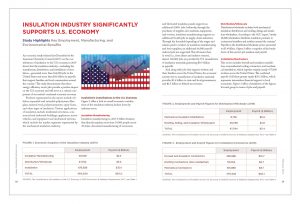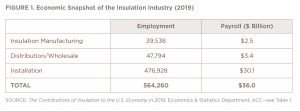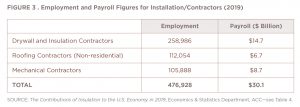Insulation Industry Significantly Supports U.S. Economy
Study Highlights Key Employment, Manufacturing, and Environmental Benefits
An economic study released last December by the American Chemistry Council (ACC) on the contributions of insulation to the U.S. economy in 2019 shows that the insulation industry—including the manufacture, distribution, and installation of insulation—generated more than 564,000 jobs in the United States and more than $36 billion in payrolls that support families and local communities around the country.1 The study demonstrates that these energy-efficiency sector jobs provide a positive impact on the U.S. economy and will serve as a critical component of our nation’s continued economic recovery.
Products represented in the report include cellulose, expanded and extruded polystyrene, fiber glass, mineral wool, polyisocyanurate, spray foam, and other types of insulation. Various applications of insulation include residential structures, commercial and industrial buildings, appliances, motor vehicles, and equipment and mechanical systems, which include the market segments represented by the mechanical insulation industry.
Insulation’s Contributions to the U.S. Economy
Figure 1 offers a look at overall economic contributions of the insulation industry, broken down by industry sector.
Insulation Manufacturing
Insulation manufacturing is a $17.5 billion business that directly employs more than 39,000 people across 45 states. Associated manufacturing of accessories and fabricated insulation panels supports an additional 9,000+ jobs. Indirectly, through the purchases of supplies, raw materials, equipment, and services, insulation manufacturing supports an additional 56,400 jobs in supply-chain industries. Through the household spending of the wages and salaries paid to workers in insulation manufacturing and their suppliers, an additional 64,000 payroll-induced jobs are supported. This all means that, in total (i.e., from direct and indirect sources), almost 160,000 jobs are provided by U.S. manufacture of insulation materials, generating $9.5 billion in payrolls.
And along with jobs that support workers and their families across the United States, the economic activity tied to manufacture of insulation materials provides $1.4 billion to state and local governments, and $2.5 billion in federal tax revenues.
Distribution/Wholesale
Distribution/wholesale includes both mechanical insulation distributors and roofing, siding, and insulation wholesalers. According to the ACC report, “nearly 48,000 wholesalers distribute insulation products to contractors/installers and retailers around the country.” Payrolls in the distribution/wholesale sector amounted to $3.4 billion. Figure 2 offers a snapshot of the breakdown of this sector’s job numbers and payroll.
Installation/Contractors
This sector includes drywall and insulation installation, nonresidential roofing contractors, and mechanical installation, which together employ nearly 477,000 workers across the United States. The combined payroll of all these groups equals $30.1 billion, which represents tremendous financial support to local economies. Figure 3 offers a breakdown of the figures for each group in terms of jobs and payroll.
Insulation Supports Energy Efficiency, Offers Environmental Benefits
“The benefits stemming from the insulation industry extend far beyond monetary contributions,” said Stephen Wieroniey, Director of ACC’s Center for the Polyurethanes Industry. “The use of insulation has valuable environmental benefits, as reduced energy consumption translates directly into lower emissions of greenhouse gases.”
By lowering energy consumption, and thus energy bills, insulation helps make businesses more competitive and gives households more spending power. The U.S. Environmental Protection Agency’s Energy Star program estimates that by adding insulation and sealing air leaks, the average household could save 15% on heating and cooling costs.2
“The insulation industry is made up of businesses large and small, rooted in every community in America,” said Curt Rich, President and CEO of the North American Insulation Manufacturers Association. “Our workforce takes pride in the fact insulation is the most cost effective step we can take to address the climate change challenge. We are particularly encouraged that the Biden climate plan identifies improving the energy efficiency of our homes and businesses as a priority.”
“The mechanical insulation industry represents a broad range of process service temperatures ranging from cryogenic to 1,200°F across the United States in commercial buildings and industrial facilities. As such, increased focus on energy efficiencies in those markets will greatly contribute to the insulation industry’s efforts to combat climate change while supporting economic recovery,” said NIA EVP/CEO Michele M. Jones.
Conclusion
With manufacturing taking place in 45 states and distribution and installation occurring across all 50 states, insulation is clearly an industry making vital contributions to the U.S. economy—from the highest levels (in terms of federal tax revenue generated) to the paychecks keeping individual workers and their families solvent in these challenging times. But, as NIA often articulates as the Voice of the Insulation Industry, the value and benefits do not stop there. The bottom line: Insulation is good for the nation’s economy, good for business, and good for the environment, which benefits us all.
For More Information
To read ACC’s report The Contributions of Insulation to the U.S. Economy in 2019, visit: https://polyurethane.americanchemistry.com/Products-Resources-and-Document-Library/Contributions-of-Insulation-to-US_2019.pdf.
To learn more about types of insulation and uses, visit: www.insulationadvocacy.org/.
Sources:
1. https://polyurethane.americanchemistry.com/Products-Resources-and-Document-Library/Contributions-of-Insulation-to-US_2019.pdf
2. https://www.energystar.gov/index.cfmc=home_sealing.hm_improvement_methodology




